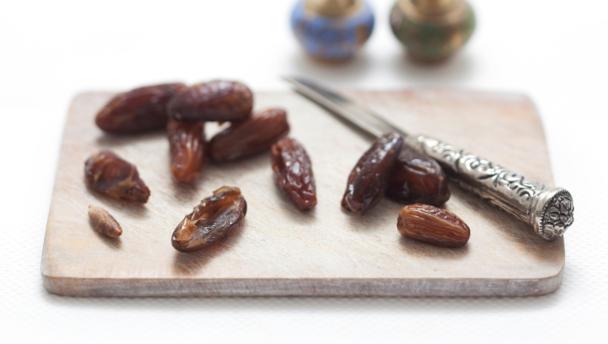

Widely grown in Arab countries, the date is the fruit of the date palm. Dates are sweet and rich with a chewy, sticky texture. Fresh dates are plump and dark brown with a glossy sheen. Dried dates look very similar and it can be hard to tell the difference if you buy them packaged. Dried dates are often coated in syrup to keep them soft and sticky.
 Chicken and lemon tagine with herby tabbouleh
Chicken and lemon tagine with herby tabbouleh
 Carrot and chickpea traybake
Carrot and chickpea traybake
 Pressed dried fruit and nut energy bars
Pressed dried fruit and nut energy bars
 Breakfast bars 2.0
Breakfast bars 2.0
 Oat, maple and pecan granola
Oat, maple and pecan granola
 Moroccan Puy lentil salad
Moroccan Puy lentil salad
 Grilled aubergine salad
Grilled aubergine salad
 James' sticky toffee pudding
James' sticky toffee pudding
 Easy sticky toffee pudding with toffee sauce
Easy sticky toffee pudding with toffee sauce
 Nutty oat energy bars
Nutty oat energy bars
As dates are harvested in late autumn and early winter, this is when the best selection is available in the shops and they’re more likely to be fresh. There are hundreds of varieties, but deglet noor from North Africa and the Middle East is the most plentiful. Medjool are large, deep-red coloured dates, usually from Jordan or California. They’re expensive but worth it for their delicious toffee-like taste. You can buy clusters of dates still on the stem or packaged in boxes – stoned or unstoned. Buy unstoned dates for the best flavour.
Fresh or dried, dates keep really well – for at least a few months in a cool, dark cupboard. They also freeze very well.
Eat dates as a sweet snack, or chop them up and scatter them onto cereal in place of sugar or honey. Chopped up they can also be added to cakes, biscuits and desserts. They’re delicious served with cheese or as an after dinner treat, stuffed with a whole almond and rolled in icing sugar. North African cuisine makes varied use of dates, notably in tagines and sweet couscous dishes.
Type the ingredients you want to use, then click Go. For better results you can use quotation marks around phrases (e.g. "chicken breast"). Alternatively you can search by chef, programme, cuisine, diet, or dish (e.g. Lasagne).